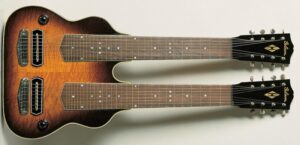A brief history
of Gibson
It’s one of the oldest guitar makers still in existence, but the journey from Orville Gibson’s hobby to a world-straddling brand has been a rollercoaster to say the least.

Image: Daniel Knighton / Getty Images
In the century or so since, the brand has changed dramatically, evolving with the times and adapting to changes in music, establishing a global reputation for innovation and quality. It’s not all been smooth sailing, and there’s certainly been some times when the brand has found itself in hot water, but it endures today as an icon of American culture.
It all began in Kalamazoo
As renowned as Gibson has become, it’s hard to imagine that it all started as Orville Gibson’s part-time hobby! He worked a variety of part-time jobs in order to fund his true passion – handcrafting musical instruments.
Orville began building acoustic guitars and mandolins in his Kalamazoo, Michigan shop in 1894. He pioneered a guitar design that featured a carved, hollow top with an oval sound hole that would become the standard for the archtop guitar. It didn’t take long for demand of his handcrafted creations to take off and so in 1902 he secured the financing to form the Gibson Mandolin-Guitar Manufacturing Company.
Sadly, he would pass away in 1918 without being able to see much of the success his namesake company would come to have.
The roaring 20s and Gibson’s first electric guitar

Guitar innovation was really starting to take off in the 1920s, and Gibson led the charge. Employee Tedd McHugh created two of their greatest engineering achievements – the adjustable truss rod and height-adjustable bridge. Even today, all Gibsons are equipped with the same truss rod McHugh designed.
1935 saw the company release their first attempt at one of the newfangled electric guitars that people were talking about – the EH-150. This was far from the electrics we know today of course, as like many early electrified instruments, it was a lap steel guitar with a Hawaiian flair. The first “electric Spanish” model, the ES-150, followed the next year, and that was a lot more like it, but despite electric guitars being the next big thing, Gibson continued to focus on quality acoustic instruments.
One of the most enduring of these came about due to a custom order for a large acoustic guitar from popular western actor Ray Whitley, the Super Jumbo J-200 “King of the Flat Tops” was born in 1937. Still popular today under the model J-200/JS-200, it is still one of the premier choices for big-bodied acoustic guitars.
Gibson was a trailblazer in acoustic guitar design, developing such storied models as the J-45 and the Southern Jumbo, which remain iconic body shapes to this day. If that wasn’t enough, the company would change the fortunes of dusty end players forever when the cutaway was developed in 1939. With the innovation allowing never-before-seen upper-fret access for the jazz and blues cats of the day, the concept soon caught on, and through its empowerment of players, would change guitar playing forever.
As World War II neared its end, Gibson was purchased by the Chicago Musical Instrument Company in 1944, with the expectation that demand for guitars would hit an all-time high – they were not wrong, and the following decades would be boom years for Gibson, wherein the brand’s most iconic instruments would be created.
In 1950, a man named Ted McCarty took over the presidency of Gibson, and under his stewardship Gibson became a dynamo of innovation, developing the P-90 pickup, the ES-175, the first triple pickup electric guitar, the ES-5. But all this innovation would be merely a springboard to what came next.
